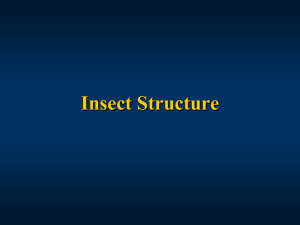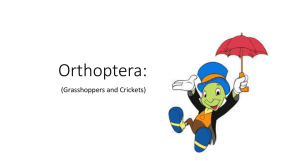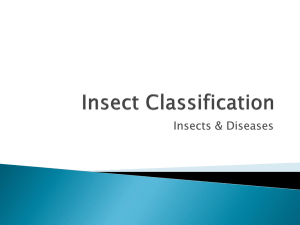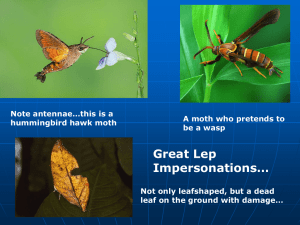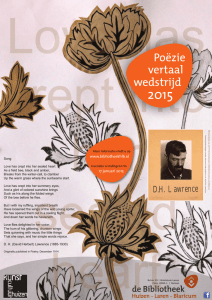The Families of British Microlepidoptera
advertisement
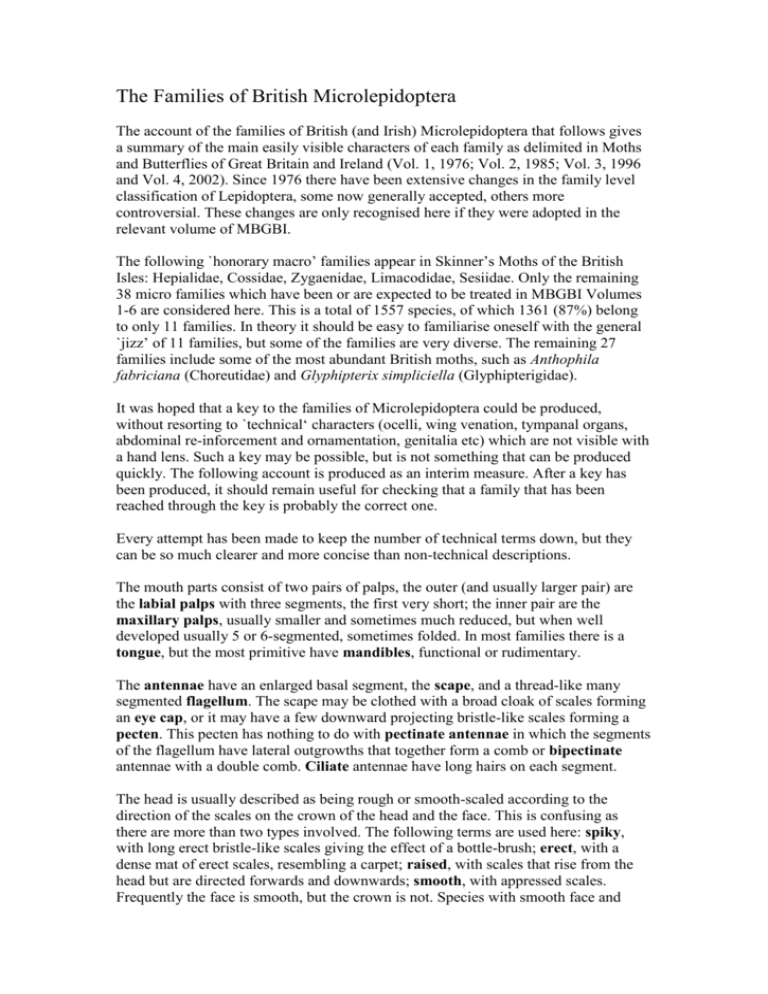
The Families of British Microlepidoptera The account of the families of British (and Irish) Microlepidoptera that follows gives a summary of the main easily visible characters of each family as delimited in Moths and Butterflies of Great Britain and Ireland (Vol. 1, 1976; Vol. 2, 1985; Vol. 3, 1996 and Vol. 4, 2002). Since 1976 there have been extensive changes in the family level classification of Lepidoptera, some now generally accepted, others more controversial. These changes are only recognised here if they were adopted in the relevant volume of MBGBI. The following `honorary macro’ families appear in Skinner’s Moths of the British Isles: Hepialidae, Cossidae, Zygaenidae, Limacodidae, Sesiidae. Only the remaining 38 micro families which have been or are expected to be treated in MBGBI Volumes 1-6 are considered here. This is a total of 1557 species, of which 1361 (87%) belong to only 11 families. In theory it should be easy to familiarise oneself with the general `jizz’ of 11 families, but some of the families are very diverse. The remaining 27 families include some of the most abundant British moths, such as Anthophila fabriciana (Choreutidae) and Glyphipterix simpliciella (Glyphipterigidae). It was hoped that a key to the families of Microlepidoptera could be produced, without resorting to `technical‘ characters (ocelli, wing venation, tympanal organs, abdominal re-inforcement and ornamentation, genitalia etc) which are not visible with a hand lens. Such a key may be possible, but is not something that can be produced quickly. The following account is produced as an interim measure. After a key has been produced, it should remain useful for checking that a family that has been reached through the key is probably the correct one. Every attempt has been made to keep the number of technical terms down, but they can be so much clearer and more concise than non-technical descriptions. The mouth parts consist of two pairs of palps, the outer (and usually larger pair) are the labial palps with three segments, the first very short; the inner pair are the maxillary palps, usually smaller and sometimes much reduced, but when well developed usually 5 or 6-segmented, sometimes folded. In most families there is a tongue, but the most primitive have mandibles, functional or rudimentary. The antennae have an enlarged basal segment, the scape, and a thread-like many segmented flagellum. The scape may be clothed with a broad cloak of scales forming an eye cap, or it may have a few downward projecting bristle-like scales forming a pecten. This pecten has nothing to do with pectinate antennae in which the segments of the flagellum have lateral outgrowths that together form a comb or bipectinate antennae with a double comb. Ciliate antennae have long hairs on each segment. The head is usually described as being rough or smooth-scaled according to the direction of the scales on the crown of the head and the face. This is confusing as there are more than two types involved. The following terms are used here: spiky, with long erect bristle-like scales giving the effect of a bottle-brush; erect, with a dense mat of erect scales, resembling a carpet; raised, with scales that rise from the head but are directed forwards and downwards; smooth, with appressed scales. Frequently the face is smooth, but the crown is not. Species with smooth face and crown may have erect scales on other parts of the head, particularly around the eyes and on the neck. The forewing is essentially triangular, with the three sides being the costa (the leading edge), the termen and the dorsum (opposite the costa). The apex is the angle between costa and termen, the tornus is that between termen and dorsum. In narrowwinged species the termen and dorsum may merge into one, so there is no tornus. The terminal margin has a fringe of cilia (hair-like scales) which may extend along the dorsum. On the hindwings the cilia also extend along the dorsum. The resting position of the moth is important. Several are illustrated in MBGBI 7 (2) covering a number of families. The front end or the rear end may be raised at an angle to the substrate. The wings may be arranged like the two sides of a pitched roof (tectiform), or rolled round the abdomen (involute), or they may be laid flat over the body, usually but not always partly overlapping. Sometimes they are extended, revealing the hindwings. The term involute covers a gradation from wings curving a little on the dorsal margin so that there is some overlapping near the base, to wings that are so inrolled as to give the moth a cylindrical appearance. Flat wings are folded so that one partly covers the other and the hindwings are completely covered. They are in fact rarely completely flat, but tend to be angled downwards. Extended wings are partly spread.usually in a horizontal plane, usually more or less exposing the hindwings. The descriptions below are intended to aid the identification to family of adult moths. Characters and behaviour of the early stages are not included, although they very often give useful pointers to particular families. After the descriptions of individual familes is a short appendix mentioning certain non-micros that are sometimes mistaken for microlepidoptera. In the family accounts below, characters that are unique or nearly so to a particular family are written in bold type. Where a feature is the norm, it is not necessarily included in the description. Thus most moths have tongues, so lack of tongue is mentioned, but not presence unless it is a valuable distinction from otherwise closely related families. There are undoubtedly omissions and inaccuracies in the text that follows. Any errors should be reported to Martin Corley mcorley@freeuk.com MICROPTERIGIDAE (MBGBI Vol 1) 5 species. Diurnal. Often on flowers (Carex, Ranunculus etc). Wingspan 5-12 mm, resting with wings in tectiform position, forming steep angle. Forewings glossy bronze or purplish. Hindwings as broad as forewings. Head with spiky scales. Mandibles present but not easily seen. Maxillary palps (folded) and labial palps present, no tongue. ERIOCRANIIDAE (MBGBI 1) 8 species. Diurnal, often flying over host trees. 9-14 mm wingspan, resting with wings in tectiform position. Forewings golden or purple. Hindwings as broad as forewings. Head with spiky scales. Mandibles absent, folded maxillary palps and labial palps present; tongue weak. NEPTICULIDAE (MBGBI 1) 96 species. Wingspan 3-10 mm. Forewings resting in tectiform position, but at very shallow angle. Hindwings narrower than forewings, but with long dorsal cilia. Head with spiky scales. Antennae rather short, 1/3 to 2/3 length of forewing, with eye cap at base, usually contrasting in colour with head. Maxillary palps well developed. Labial palps reduced. Tongue absent OPOSTEGIDAE (MBGBI 1) 4 species. Wingspan 7-12 mm. Very similar to Nepticulidae, usually larger, eye caps larger and same colour as head, which has flat scales apart from a tuft of erect scales between the antennae. Forewings white or pale, with or without markings. TISCHERIIDAE (MBGBI 1) 5 species. Wingspan 6-11 mm. Rest with front end raised and wings in tectiform position. Forewings uniformly coloured or with a partial dark border. Hindwings narrower than forewings, with long dorsal cilia. Head with erect scales on top, flat scales on face. Antennae almost as long as wings, without conspicuous eye cap. Labial palps short, drooping. Maxillary palps rudimentary. Tongue short. INCURVARIIDAE (MBGBI 1) 27 species. The family, as treated in MBGBI is now considered to consist of three families: INCURVARIIDAE, PRODOXIDAE and ADELIDAE. For convenience they are treated here as two families: Adelidae and Incurvariidae. ADELIDAE 15 species. Wingspan 8-23 mm. Instantly recognisable by the very long antennae, much longer than the forewings (exception Adela fibulella, almost always found on Veronica chamaedrys flowers). Diurnal, with glossy wings except for Nematopogon. Many caddis flies have equally long antennae, but hold them pointing straight forwards, not spreading as in Adelidae. INCURVARIIDAE 12 species. Wingspan 7-18m mm. Body held near horizontal at rest with wings in tectiform position. Forewings more than twice as long as wide (cf Psychidae), not glossy, brown or blackish, unmarked or with white or yellow spots on dorsal margin, or on dorsal and costal margins or with fasciae, one species with additional pale spotting. Hindwings as wide as forewings. Head with erect scales, or with smooth scales on face. Antennae shorter than forewing, simple or in the males of Incurvaria pectinate. Tongue reduced or absent. HELIOZELIDAE (MBGBI 1) 5 species. Wingspan 5-9 mm. Adults fly by day in late spring over the host trees and shrubs. Wings held at rest in tectiform position at a steep angle. Forewings with pale dorsal spot or spots or with a fascia and a costal and a tornal spot. Hindwings slightly narrower than forewings, with long dorsal cilia. Head with smooth scales. Antennae 2/3 length of forewing. Labial palpi short, drooping. Tongue well developed. PSYCHIDAE (MBGBI 2) 20 species. Females wingless except Narycia and Diplodoma. Three species without males. Wingspan 7-28 mm. Wings held in tectiform position. Forewings in many species not more than twice as long as wide, usually dull brown or grey, some species with speckled pattern, a few with indistinct fasciae. Hindwings as broad as forewings. Head with erect, raised or smooth scales. Mouthparts much reduced. Antennae bipectinate or in a few species with long cilia. The latter species may be confused with Tineidae. TINEIDAE (MBGBI 2) 58 species. Wingspan 6-30 mm. Wings held in tectiform position. Forewings long, often without distict tornal angle, often dull brown. Hindwings as wide as forewings. Head with spiky scales (exception Psychoides with smooth scales). Labial palps pointing forwards or down, second segment with spreading bristles (sometimes difficult to see). Maxillary palps folded, tongue weakly developed. Antennae about ¾ length of forewings. OCHSENHEIMERIIDAE (MBGBI 2) 3 species. Wingspan 9-12 mm. Diurnal. Forewings somewhat parallel-sided and with distict tornal angle. Hindwings as wide as forewings. Head densely covered with spiky scales. Labial palps covered with spreading scales. Antennae held at a wide angle, short, slightly over half length of forewing, often clothed with spreading scales. Tongue present. LYONETIIDAE (MBGBI 2) 21 species. Wingspan 5-10 mm. Resting position with front end raised (Leucoptera, Bedellia) or not (Lyonetia, Bucculatrix), wings in tectiform position. Forewings narrow. Hindwings narrow with long dorsal cilia. Head spiky scaled (Bucculatrix) or erect scaled on crown. Eye caps present, most conspicuous in Bucculatrix, absent in Bedellia. Antennae from 2/3 length of forewing to a little longer than forewing. Mouthparts all weakly developed. Modern treatments of the group divide them into three families: Lyonetiidae, Bucculatricidae and Bedelliidae. Bedellia could be mistaken for a Gracillariid. HIEROXESTIDAE (MBGBI 2) 3 species. Only one species is found outdoors, and that only in the Scilly Isles. The others are imported with bananas. Wingspan 8-28 mm. Close to Tineidae, but face has a forward pointing keel of scales. GRACILLARIIDAE (MBGBI 2) 90 species. Wingspan 4.5-16 mm. Rest with fore end raised at around 40º (except Phyllonorycter, only slightly raised), often showing tufts of scales on legs. Forewings at rest in involute position. Forewings narrow, without distinct tornus, markings absent or more often well developed. Hindwings narrow, with long dorsal cilia. Head smooth or erect scales. Antennae from nearly as long as to slightly longer than forewing, without eye cap. Labial palpus slender, pointing forwards. Tongue present. PHYLLOCNISTIDAE (MBGBI 2) 3 species. Wingspan 6-8 mm. Closely related to Gracillariidae. Rest with body close to horizontal. Antennae 4/5 length of forewing with small eye cap. Wing markings resembling Leucoptera (Lyonetiidae) or Phyllonorycter (Gracillariidae). CHOREUTIDAE (MBGBI 2) 6 species. Wingspan 9-18 mm. Diurnal. Rest with body horizontal, but held well up on legs and wings held flat and slightly diverging (except Tebenna with wings involute). Forewings broad. Hindwings broader than forewings. Head smooth scaled. Antennae half to 2/3 length of forewing. Labial palpi pointed forewards, with tufts of scales beneath second segment in some genera.. A very distinctive family. The broad wings suggest Tortricidae, but the resting position is quite different. GLYPHIPTERIGIDAE (MBGBI 2 and 3) 8 species. 7 species of Glyphipterix were treated in MBGBI 2. The genus Orthotelia was added to the family in MBGBI 3. Wingspan 6-16 mm (Glyphipterix); 18-28 (Orthotelia). At rest the wings are raised and lowered in a characteristic fashion in Glyphipterix. Those of Orthotelia are kept motionless in a tectiform position. Forewings moderately elongate but with distinct tornus, hindwings broad, but not as broad as forewings. Head smooth. Antennae about 3/5 length of forewing. Labial palpus slender, slightly upcurved (strongly in Orthotelia). Tongue well developed (except Orthotelia). Most Glyphipterix species have a series of costal markings and a dorsal hook which could lead to confusion with Cydia spp. (Tortricidae). Orthotelia resembles one of the smaller `Wainscots’(Noctuidae). Orthotelia is very ill-matched with Glyphipterix. Its placement in this family is highly questionable. DOUGLASIIDAE (MBGBI 2) 2 species. Wingspan 8-9 mm. Mainly diurnal. Rest with front end raised. Forewings narrow without tornus, dark grey, with or without spot or fascia.. Hindwings very narrow with long dorsal cilia. Head with smooth scales. Antennae without eye cap. Labial palps pointing foreward, short.. Associated with Vipers Bugloss (Echium). HELIODINIDAE (MBGBI 2) 1 species, extinct in Britain since 1820. YPONOMEUTIDAE (MBGBI 3) 76 species. Wingspan 7-33 mm. Wings at rest in tectiform or involute position, antennae rest along wings or pointing forwards, body held horizontal or with rear end raised. Forewings elongate, with or without distinct tornus. Hindwings as wide as forewings or sometimes and with long dorsal cilia. Head with smooth, raised or erect scales. Antennae about ¾ length of forewing, without eye cap. Labial palps pointing forwards or curved upwards, in Ypsolopha with long tuft of forward pointing scales on second segment. Tongue present, though sometimes weakly developed. A very diverse family, now sometimes split into several families or subfamilies. Yponomeutinae have rows of dots along the forewings. Ypsolophinae and Plutellinae have forward pointing antennae and tufted labial palps; some Ypsolopha have hooked wingtips. Acrolepiinae have upcurved labial palps and erect scales on crown. ROESLERSTAMMIIDAE (MBGBI 3) 2 species. Wingspan 11-14 mm. Forewings metallic bronze. Hindwings slightly broader than forewings. Head with erect scales. Antennae about 4/5 length of forewing, dark with a white section before apex, scape with pecten. Labial palps long, curved upwards. EPERMENIIDAE (MBGBI 3) 8 species. Wingspan 8-14 mm. At rest forend slightly raised and wings tectiform to involute, antennae laid alongside wings. Forewings elongate, sometimes with scale tufts on dorsal margin, and/or with hooked apex. Hindwings narrower than forewings, dorsal cilia usually long. Head smooth. Antenna 3/5 wing length. Labial palpus curved upwards. SCHRECKENSTEINIIDAE (MBGBI 3) 1 species. Wingspan 10-12 mm. Partly diurnal. Forewings at rest held flat and slightly diverging, hindlegs held up in the air. Forewings narrow. Hindwings narrow, not as broad as forewings, dorsal cilia moderately long. Head smooth. Antennae 3/5 length of forewing. Labial palps slightly upcurved. The families Coleophoridae to Gelechiidae constitute the superfamily Gelechioidea, which may be distinguished from all the previous families and from the Tortricidae by the presence of scales on the tongue. COLEOPHORIDAE (MBGBI 3) 108 species. Wingspan 6-22 mm. Resting position nearly horizontal, wings involute, antennae pointing forwards or diverging. Forewing narrow without tornal angle, often without markings. Hindwing narrower than forewing, dorsal cilia long. Head smooth. Antenna 2/3 to ¾ length of forewing. Labial palps slender, moderately ascending. Each segment of abdomen of Coleophora with paired patches of tiny spines which show through scales. ELACHISTIDAE (MBGBI 3) 46 species. Wingspan 6.5-14 mm. Mainly crepuscular. Resting position nearly horizontal, wings tectiform to involute, antennae directed backwards. Forewings about three times as long as wide, with indistinct tornal angle, usually white, grey or blackish, ochreous or brown coloration in only a few species, markings most frequently consist of one or two pale fasciae and/or paired costal and tornal spots. Hindwings narrower than forewings, dorsal cilia long. Head smooth. Antennae ¾ length of forewings, scape with pecten. Labial palps slender, drooping, pointing forwards or curved upwards. . OECOPHORIDAE (MBGBI 4(1)) 84 species. Wingspan 7-30 mm. Body held near horizontally at rest rarely with tail up (e.g. Batia unitella), wings in tectiform position, or flat and overlapping, (involute in Stathmopoda with hind legs held up in the air, projecting between front and mid-legs), antennae often held along sides of body below wings, but pointing forwards in Esperia. Forewings often broad, usually narrower with weak tornal angle in smaller species, very varied in markings, some species brightly coloured. Hindwings usually as broad as forewings or a little broader, but narrower with long dorsal cilia in some of the smaller species, in Depressariinae the anal angle is expanded, producing a sinuation in the dorsal margin. In some Chimabachinae the females have wings much reduced. Head smooth. Antennae about 2/3 length of forewing (except Carcina, as long as forewing), scape often with pecten. Labial palpi strongly developed usually curved upwards, but some genera with exceptionally long second segment, and third segment pointing forwards or upwards. A very diverse family, now frequently split into separate subfamilies or families. The flat-winged species are sometimes mistaken for Gelechiidae,which differ in the hindwing shape, and rarely have an antennal pecten. ETHMIIDAE (MBGBI 4(1)) 6 species. Wingspan 15-34 mm. Body held nearly horizontal at rest, wings in involute position, antenna along side of body. Forewings elongate, with tornal angle, handsomely marked in black and white or pale grey. Hindwings broader than forewings. Thorax with four of five black spots. Head smooth. Antennae about 2/3 length of forewing, scape with pecten in most species. Labial palps slender, curved upwards. Abdomen yellow in some species. The black dots on thorax and black spotted wings could cause confusion with Yponomeuta species. AUTOSTICHIDAE (MBGBI 4(1)) 4 species. Wingspan 11-16 mm. Rest with body near horizontal, wings folded flat and partly overlapping, antennae along side of body. Forewings quite narrow, mainly blackish with pale fasciae. Hindwings about equal in width to forewings. Head smooth. Antenna about 2/3 forewing length. Labial palps ascending in front of face. Formerly paced in Gelechiidae, but lacks the gelechiid hindwing shape. BLASTOBASIDAE (MBGBI 4(1)) 4 species. Wingspan 13-22 mm. Resting with body near horizontal, wings in involute position and antennae along side of body. Forewings elongate, without tornal angle, dull grey, brown or ochreous with weak markings, usually with a pair of dots at 2/3 length. Hindwings about equal in width to forewings. Head smooth. Antennae 2/3 length of forewing, scape with pecten, partly concealed by dense scales, second segment in male notched. Labial palps strongly curved upwards, third segment pointed. [ MOMPHIDAE sensu lato. Until recently British lepidopterists have treated the Momphidae as a very diverse family characterised by very narrow hindwings and strongly upcurved labial palps. Similarly very diverse families such as Lyonetiidae, Yponomeutidae and Oecophoriae have been retained as single units in MBGBI, although generally recognised outside Britain as containing several families. However, in the case of the Momphidae, the following four families are recognised in MBGBI ]. BATRACHEDRIDAE (MBGBI 4(1)) 3 species. Wingspan 9-15 mm. Rest with front end slightly raised, wings involute and antennae held alongside body. Forewings very elongate, without tornal angle, but angled backwards at 2/3 length of costa, grey-brown or ochreous. Hindwing short, very narrow, with very long dorsal cilia. Head smooth. Antenna 4/5 length forewing. Labial palps ascending. AGONOXENIDAE (MBGBI 4(1)) 6 species. Wingspan 8-14 mm. Forewing with tufts of raised scales, metallic in Chrysoclista. Antennae 4/5 to 7/8 forewing length. Other characters as in Momphidae. MOMPHIDAE (MBGBI 4(1)) 15 species. Wingspan 7-18 mm. Rest with body near horizontal, forewings somewhat involute and antennae alongside body. Forewings elongate, without tornal angle, usually with scale tufts, sometimes with metallic markings. Hindwings narrower than forewings, dorsal cilia long. Head smooth. Antennae ¾ length of forewing, scape with or without pecten. Labial palps ascending, with segment three sometimes reaching above head. COSMOPTERIGIDAE (MBGBI 4(1)) 13 species. Wingspan 8-22 mm. Forewing elongate to very narrow, smooth or with scale tufts, tufts and sometimes fasciae may be metallic. Antennae ¾ to 4/5 lenth of forewing. Other characters as in Momphidae. SCYTHRIDIDAE (MBGBI 4(1)) 12 species. Wingspan 8-20 mm. Diurnal, but not often seen flying. The reting moth is often described as drop-shaped, with body nearly horizontal, wings involute and antennae along side of body. Forewings elongate, tornal angle indistinct, dull brown or glossy bronze coloured, often without markings. Hindwings slightly narrower than forewings, dorsal cilia long in species with narrowest hindwings. Head smooth. Antennae half to 2/3 length of forewing, scape with pecten.. Labial palps curved, ascending, not reaching above head. GELECHIIDAE (MBGBI 4(2)) 161 species. Wingspan 8-22 mm. Resting position with front end slightly to strongly raised, wings involute or flat, antennae along side of body. Forewings moderately to strongly elongate, tornal angle present or not, white, grey, brown, ochreous or blackish, colouration and markings very varied, but two discal spots and one in the fold are usually present, scale tufts occur in a number of species, metallic markings in a few. Hindwings vary from narrower than forewings to wider, termen concave so that apex is produced, often forming a conspicuous prominence, or sharp point, although the effect is progressively reduced with increasing hindwing width. In genera such as Anacampsis this feature is undetectable and confusion with Oecophoridae (q.v.) is possible. Head smooth. Antennae about 2/3 length of forewing, scape occasionally with pecten. Labial palps curved, strongly ascending, often reaching above head, second segment frequently with conspicuous tuft of scales, occasionally elongate and pointing straight forwards, when third segment usually short. TORTRICIDAE 381 species. Wingspan 8-30 mm. Rest with body held horizontally, wings flat and overlapping, tectiform or involute, antennae laid back above the wings or diverging and pointing up at 45º. Forewings often rather broad, with distict tornal angle, a wide wingbase is characteristic of many species, some have the apex curved forwards; the males of many species have a costal fold in the basal part. Hindwings as broad as or broader than forewings. Wings much reduced in female Exapate. Head with erect or raised scales on crown, face smooth. Antennae short, less than 2/3 length of forewing. Labial palps short, drooping, pointing forwards or slightly upcurved, second segment densely scaled or tufted, third segment short and blunt. (Sparganothis has long palps pointing straight forward, but beware Nycteola (Noctuidae)). ALUCITIDAE 1 species. Wingspan 13-16 mm. All wings divided into six `fingers’. PYRALIDAE 220 species. Wingspan 13-41 mm (some female Acentria are wingless). Resting insect with body parallel to surface, or raised at the front, occasionally with tail raised, or body raised above surface on long legs, wings held flat, overlapping or not and often spread to various degrees, tectiform or involute, antennae usually laid back over thorax and abdomen. Forewing elongate to broadly triangular, very varied in markings, but commonly with two cross lines in central section of wing. Hindwings as wide as forewings or wider, in many species with markings somewhat resembling those on forewings. Head with raised scales on crown, face smooth or with raised or erect scales. Antennae about ¾ length of forewing. Labial palps very varied, but most often long and directed forwards. Tongue with dense scales at base. There are several subfamilies. Two of these have species with relatively narrow forewings, resting with wings involute. Crambidae have long, forward directed palps and characteristically rest on grass stems upside down. Phycitinae have palps varying from short to long, most often ascending or pointing forwards; the antennae of the males of many species have a scaled expansion on the base of the antennal flagellum immediately beyond the scape. PTEROPHORIDAE 40 species. Wingspan 11-35 mm. Rest horizontally with wings extended at right angles to body, forewings sometimes completely covering hindwings. Forewings divided into two fingers, hindwings into three. Legs very long. Agdistis has wings undivided and at rest wings are extended upwards at 40º to horizontal, but stands up high on its very long slender legs. APPENDIX Non-micros. Several small Noctuidae (Rivula sericealis, Schrankia species, Hypenodes) and Nolidae have been frequently mistaken for micros. They differ from Pyralidae (with which they are most likely to be confused) in lacking scales at the base of the tongue. Nycteola looks like a tortricid, but the long straight palps distinguish it from all Tortricidae except Sparganothis. Owl Flies (Diptera: Psychodidae) have a moth-like flight, but there is only one pair of wings which are covered with long hairs. Whiteflies (Hemiptera: Aleyrodidae) also have a moth-like flight, but the wings are covered in wax. Very few moths are as small (wingspan ca. 3 mm), and nothing this small is pure white. Hydroptilidae are tiny caddis-flies which regularly come to light and can be taken for tiny micros. They run even faster than any micro and have spiky hairs on head and body and even on the wings.


